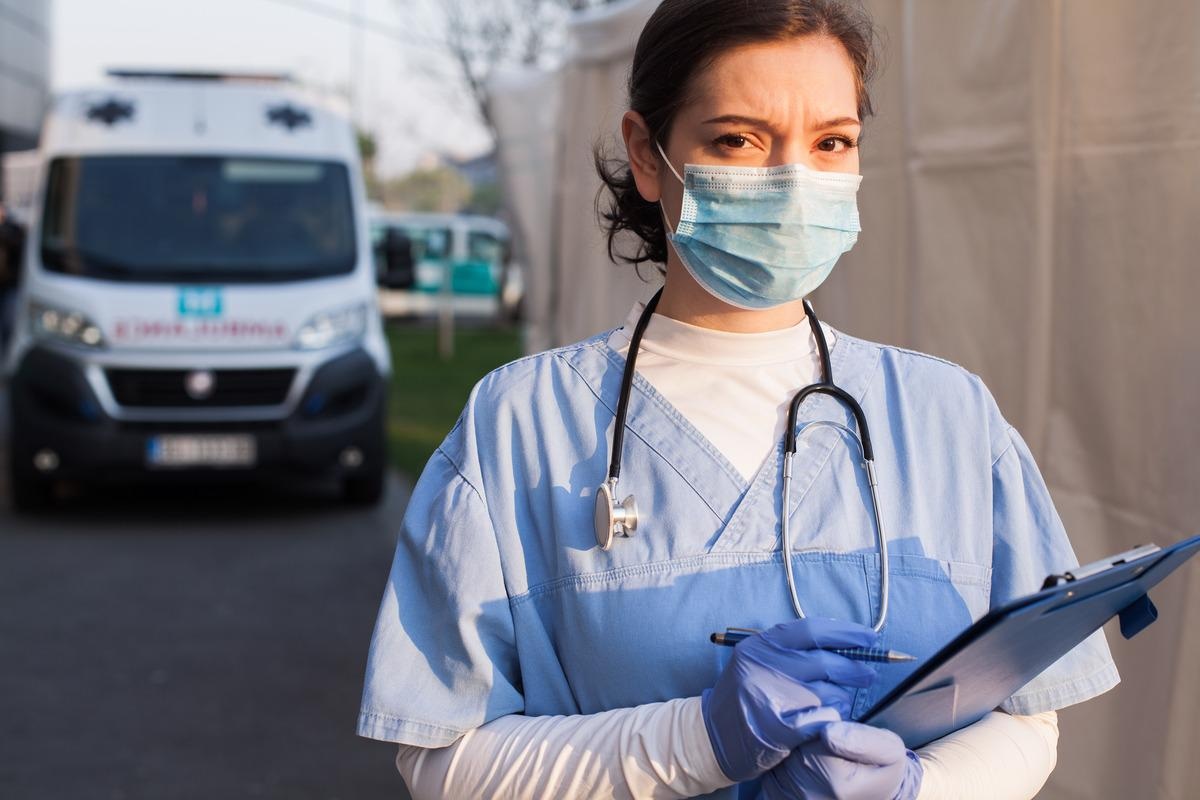During the ongoing pandemic of coronavirus disease 2019 (COVID-19), caused by the severe acute respiratory syndrome coronavirus 2 (SARS-CoV-2), there has been a constant and often overwhelming demand for healthcare services for those critically or severely affected by the virus.
 Study: Reduced Titers of Circulating Anti-SARS-CoV-2 Antibodies and Risk of COVID-19 Infection in Healthcare Workers during the Nine Months after Immunization with the BNT162b2 mRNA Vaccine. Image Credit: Cryptographer/Shutterstock
Study: Reduced Titers of Circulating Anti-SARS-CoV-2 Antibodies and Risk of COVID-19 Infection in Healthcare Workers during the Nine Months after Immunization with the BNT162b2 mRNA Vaccine. Image Credit: Cryptographer/Shutterstock
It is estimated, by the World Health Organization (WHO), that in less than a year and a half, up to 180,000 healthcare workers (HCW) may have died of the disease.
This catastrophic loss of qualified workers in an area that is key to the successful treatment of this disease has led to the breakdown of essential health services. This means that HCW are at top priority for vaccination, in view of their high risk for infection due to heavy and frequent exposure to the virus, as well as their irreplaceable role during the pandemic.
Background
The intensity of human illness and deaths caused by the pandemic led to the development of COVID-19 vaccines at an unprecedented speed, using experimental techniques. After testing was completed, four vaccines were approved for use in Italy, in December 2021, the first being the Pfizer and Moderna vaccines.
These were developed on the messenger ribonucleic acid (mRNA) platform, encoding the viral spike protein. The receptor-binding domain (RBD) of the spike protein is the immunodominant target of neutralizing antibodies to the virus.
Anti-RBD antibodies neutralize the virus by inhibiting viral binding to the host cell angiotensin converting enzyme 2 (ACE2) receptor. The titers of anti-RBD and anti-spike neutralizing antibodies are correlated with protective immunity against natural infection, repeat infection, and breakthrough infections.
Conversely, antibodies to the viral nucleoprotein antigen, found in convalescent serum but not after vaccination, are thought to be binding non-neutralizing antibodies.
After two doses of an mRNA vaccine, protective immunity in the form of B and T cell responses is observed after one to two weeks, though a single dose is also known to produce detectable levels of protection in some subjects. The duration of such protection is still a subject of controversy, as is the relative importance of B and T cell immunity.
Some studies have suggested that vaccination results in stronger neutralizing activity and higher anti-S IgG titers, than natural infection brings about. The strong immunological response initially elicited by vaccination appears to wane as antibody titers fall, with apparent reductions in memory T and B cell numbers.
It remains to be known whether this means reduced protection against infection, severe disease and death over time, but available evidence seems to suggest as much.
The current study, published in the journal Vaccines, aimed to understand the risk of infection given certain serological parameters, in a group of vaccinated HCWs with high rates of exposure to the virus, followed up at 9 months from vaccination. This could help assess the need for additional doses of the vaccine to boost immunity.
What did the study show?
The researchers examined antibody responses to the virus in a cohort of approximately 800 HCWs, including physicians, nurses, and other healthcare professionals, all of whom had received two doses of the Pfizer vaccine.
Of these, 25 had a history of COVID-19 prior to vaccination, and 13 were infected afterwards. There were no infections reported in the interval between the two doses.
Anti-Spike anti-RBD antibodies were found in serum samples of almost all participants (two were negative). Only one serology examination was performed on 620 subjects, and two in 173 of them, during the study period. Four of these had COVID-19 between the two assessments.
The total duration from the second vaccine dose and the serological test was 123 days on average, with a range of 13-253 days.
Antibody testing was done at >90 days and >150 days from the second dose in half, and a fifth, of the participants, respectively. The results showed a waning mean antibody titer over time, from a mean of 1,600 U/mL in the within-90-days period, and 1,000 U/mL in the within 150-days period. When evaluated after 150 days from the second dose, the mean antibody titer was ~700 U/mL.
Overall, antibody titers were somewhat higher in females. Among those who were tested twice, over 11-483 days, antibody titers showed correlations with a history of prior infection, duration of time between assessment, and the initial titer. Age and sex did not play a significant role, however.
Implications
Earlier studies seemed to indicate that lower titers of neutralizing antibodies could protect against severe disease even if not against symptomatic infection. For up to 8 months after natural infection, antiviral antibodies have been detectable in the serum, vs up to 6 months from the second dose of an mRNA vaccine.
Over a tenth of convalescents had no detectable antibodies, while over one in five showed rapidly declining titers. This was not seen with two doses of an mRNA vaccine in immunocompetent individuals, however, which led to an immune response with both higher titers and longer duration of detectable antibody responses.
The latter is particularly important as it helps determine whether an additional booster dose is required for those at high risk of infection, and those who are at risk for severe outcomes. Reassuringly, the study shows that anti-RBD antibodies are found in almost all double-vaccinated people for up to 9 months later.
The scientists also found that circulating antibody titers decline in response to the initial titer measured in this study and the duration between successive measurements. This is in contrast to the case with most vaccines, the long-term antibody responses typically last for 10 or more years at stable levels, after which mild symptomatic reinfection may occur.
The findings thus confirm that the COVID-19 vaccines play a significant role in protecting against severe infection, and support the recommendation that all HCWs take the vaccine, even as increasing numbers of HCWs turn against or hesitate to take COVID-19 vaccines.
A prior history of COVID-19 was associated with strong durable antibody responses, irrespective of all other factors. Further work is required to understand how anamnestic responses to the virus encountered prior to vaccination affect protection to the virus later. This is likely to be all the more important as both symptomatic and asymptomatic infections arise frequently among HCWs.
The magnitude of the initial peak antibody response is related to the durability of the response, as in other viral infections, as well as to the age and sex in the case of vaccine-induced immunity. Males and older individuals had lower antibody titers, and even among younger people, the neutralizing activity waned with age.
Interestingly, although antibody titers clearly waned over time following vaccination, no cases of severe COVID-19 were diagnosed among the HCWs enrolled in our study. Collectively, these data underscore the importance of achieving high levels of vaccine coverage among HCWs. The need for booster doses, specifically for those at high risk of occupational exposure, should also be carefully addressed.”
- Coppeta, L. et al. (2022). Circulating Anti-SARS-CoV-2 Antibodies and Risk of COVID-19 Infection in Healthcare Workers during the Nine Months after Immunization with the BNT162b2 mRNA Vaccine. Vaccines. doi: https://doi.org/10.3390/vaccines10020141 https://www.mdpi.com/2076-393X/10/2/141
Posted in: Medical Science News | Medical Research News | Disease/Infection News
Tags: ACE2, Angiotensin, Antibodies, Antibody, Antigen, B Cell, Cell, Coronavirus, Coronavirus Disease COVID-19, covid-19, Enzyme, Healthcare, Immune Response, immunity, Pandemic, Protein, Receptor, Respiratory, Ribonucleic Acid, SARS, SARS-CoV-2, Serological Test, Serology, Severe Acute Respiratory, Severe Acute Respiratory Syndrome, Spike Protein, Syndrome, Vaccine, Virus

Written by
Dr. Liji Thomas
Dr. Liji Thomas is an OB-GYN, who graduated from the Government Medical College, University of Calicut, Kerala, in 2001. Liji practiced as a full-time consultant in obstetrics/gynecology in a private hospital for a few years following her graduation. She has counseled hundreds of patients facing issues from pregnancy-related problems and infertility, and has been in charge of over 2,000 deliveries, striving always to achieve a normal delivery rather than operative.
Source: Read Full Article
